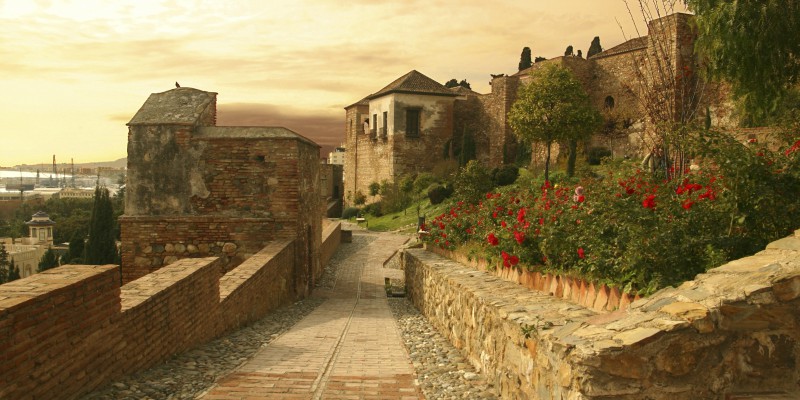MÁLAGA
Malaga Main Sights
The old historic centre of Málaga reaches the harbour to the south. In the north it is surrounded by mountains, the Montes de Málaga (part of the Baetic Cordillera) lying in the southern base of the Axarquía hills, and two rivers, the Guadalmedina – the historic center is located on its left bank – and the Guadalhorce, which flows west of the city into the Mediterranean.
The oldest architectural remains in the city are the walls of the Phoenician city, which are visible in the cellar of the Museo Picasso Málaga.
The Roman theatre of Málaga, which dates from the 1st century BC, was rediscovered in 1951.
The Moors left posterity the dominating presence of the Castle of Gibralfaro, which is connected to the Alcazaba, the lower fortress and royal residence. Both were built during the Taifa period (11th century) and extended during the Nasrid period (13th and 14th centuries). The Alcazaba stands on a hill within the city. Originally, it defended the city from the incursions of pirates. Later, in the 11th century, it was completely rebuilt by the Hammudid dynasty. Occupying the eastern hillside that rises from the sea and overlooks the city, the Alcazaba was surrounded by palms and pine trees.
Like many of the military fortifications that were constructed in Islamic Spain, the Alcazaba of Málaga featured a quadrangular plan. It was protected by an outer and inner wall, both supported by rectangular towers, between which a covered walkway led up the slope to the Gibralfaro (this was the only exchange between the two sites). Due to its rough and awkward hillside topography, corridors throughout the site provided a means of communications for administrative and defensive operations, also affording privacy to the palatial residential quarters.
The entrance of the complex featured a grand tower that led into a sophisticated double bent entrance. After passing through several gates, open yards with beautiful gardens of pine and eucalyptus trees, and the inner wall through the Puerta de Granada, one finds the 11th and 14th century Governor's palace. It was organised around a central rectangular courtyard with a triple-arched gateway and some of the rooms have been preserved to this day. An open 11th century mirador (belvedere) to the south of this area affords views of the gardens and sea below. Measuring 2.5 square metres, this small structure highlighted scalloped, five-lobed arches. To the north of this area were a waterwheel and a Cyclopean well (penetrating forty metres below ground), a hammam, workshops and the monumental Puerta de la Torre del Homenaje, the northernmost point of the inner walls. Directly beyond was the passage to the Gibralfaro above.
The Church of Santiago (Saint James) is an example of Gothic vernacular Mudéjar, the hybrid style that evolved after the Reconquista incorporating elements from both Christian and Islamic tradition. Also from the period is the Iglesia del Sagrario, which was built on the site of the old mosque immediately after the city fell to Christian troops. It boasts a richly ornamented portal in the Isabeline-Gothic style, unique in the city.
The Cathedral and the Episcopal Palace were planned with Renaissance architectural ideals but there was a shortfall of building funds and they were finished in Baroque style.
The Basílica y Real Santuario de Santa María de la Victoria, built in the late 17th century, has a chapel in which the vertical volume is filled with elaborate Baroque plasterwork.
Other sights include:
Walls. Phoenician, Roman, Byzantine, Arab and Spanish remains of the defensive compounds of the city.
La Concepción, botanical and historical garden.
Church of the Sacred Heart.
San Felipe Neri Church.
Church of the Holy Martyrs.
Atarazanas Market.
Palm grove and Muelle Uno. Port of Málaga.
Anglican Cemetery of St. George.
San Miguel Cemetery.
La Malagueta bullring.
Pedregalejo, old fishing district.
(Texto de Wikipedia https://en.wikipedia.org/wiki/M%C3%A1laga )

